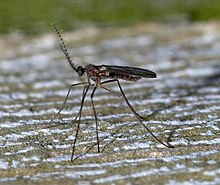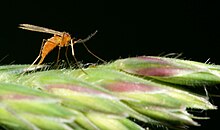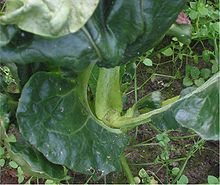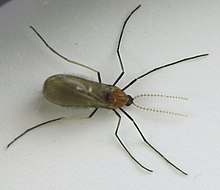
A midge is any small fly, including species in several families of non-mosquito nematoceran Diptera. Midges are found on practically every land area outside permanently arid deserts and the frigid zones. Some midges, such as many Phlebotominae and Simuliidae, are vectors of various diseases. Many others play useful roles as prey for insectivores, such as various frogs and swallows. Others are important as detritivores, and form part of various nutrient cycles. The habits of midges vary greatly from species to species, though within any particular family, midges commonly have similar ecological roles.

The Agromyzidae are a family of flies, commonly referred to as the leaf-miner flies for the feeding habits of their larvae, most of which are leaf miners on various plants. It includes roughly 2,500 species, they are small, some with wing length of 1 mm. The maximum size is 6.5 mm. Most species are in the range of 2 to 3 mm.
Orseolia oryzae, also called the Asian rice gall midge, is a species of small fly in the family Cecidomyiidae. It is a major insect pest of rice. The damage to the crop is done by the larvae which form galls commonly known as "silver shoots" or "onion shoots". The rice plant is stunted and the seed heads fail to develop.

Horace Francis Barnes was an English entomologist who specialised in Diptera.

Contarinia is a genus of midges, small flies in the family Cecidomyiidae. There are over 300 described species in the genus.

A gnat is any of many species of tiny flying insects in the dipterid suborder Nematocera, especially those in the families Mycetophilidae, Anisopodidae and Sciaridae. Most often they fly in large numbers, called clouds. "Gnat" is a loose descriptive category rather than a phylogenetic or other technical term, so there is no scientific consensus on what constitutes a gnat. Some entomologists consider only non-biting flies to be gnats. Certain universities and institutes also distinguish eye gnats: the Smithsonian Institution describes them as "non-biting flies, no bigger than a few grains of salt, ... attracted to fluids secreted by your eyes".
Dasineura communis, the gouty vein midge, is a species of gall midges in the family Cecidomyiidae.
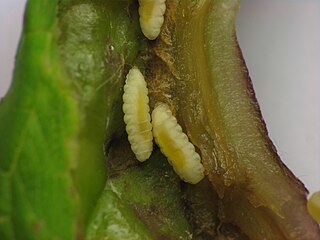
Dasineura tumidosae is a species of gall midge, insects in the family Cecidomyiidae.
Dasineura parthenocissi is a species of gall midge, insects in the family Cecidomyiidae. It forms galls on Parthenocissus quinquefolia. The gall can host the parasitic wasp Platygaster munita.

Contarinia negundinis, known generally as boxelder gall midge, is a species of gall midges in the family Cecidomyiidae. Other common names include the boxelder bud gall midge and boxelder leaf gall midge. It is the only North American species that enters diapause during the pupal stage of development.
Dasineura trifolii, the clover leaf midge, is a species of gall midges, insects in the family Cecidomyiidae.
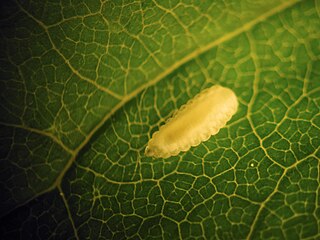
Dasineura pellex, the ash bullet gall midge, is a species of gall midge, insects in the family Cecidomyiidae.
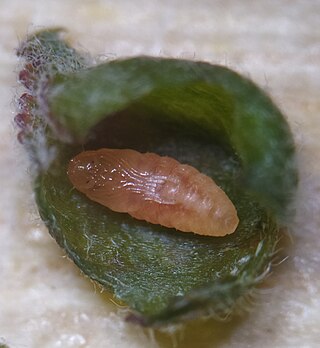
Dasineura gleditchiae, commonly known as the honeylocust podgall midge, is a species of gall midge in the family Cecidomyiidae. Native to North America, it is an invasive species in parts of Europe. The honeylocust podgall midge is a pest of honey locust, forming galls on the foliage.

Rhopalomyia clarkei is a species of gall midges, insects in the family Cecidomyiidae. The larvae induce galls on two hosts: Solidago altissima and Solidago rugosa and are found in north-eastern and north central North America.
Rabdophaga rosacea is a species of gall midge that creates rosette galls on roses found in the central plains of North America.
Anabremia is a genus of gall midge in the family Cecidomyiidae. The six described species are found in the Palearctic and likely inquilines of Dasineura galls on plants in the legume family. This genus was first described by Jean-Jacques Kieffer in 1912.
Geromyia penniseti, the millet grain midge, is a species of gall midge in the family Cecidomyiidae. It is found in Africa and South Asia. During the rainy season, it feeds on the developing grains of pearl millet plants.
Stenodiplosis sorghicola, the sorghum midge, is a species of gall midge in the family Cecidomyiidae. It is a pest of millets. The species is native to Africa and is also found in India. During the rainy season, it feeds on the developing grains of pearl millet plants.
